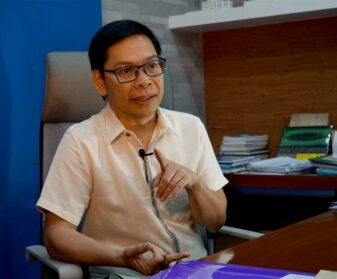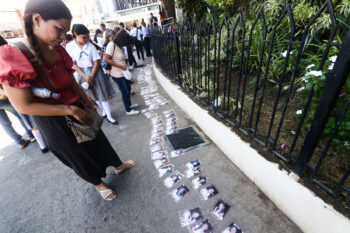DAVAO CITY (MindaNews/16 December) — With the situation getting worse everyday, handling the aftermath of Typhoon Pablo should be left in the hands of a competent crisis manager. Unfortunately, there is no one yet on the ground who fits that job description.
The public has been agonizing over the past few days as the magnitude and extent of the calamity in the Davao provinces continue to unfold day by day. What we are seeing is not the complete picture yet!
We do not wish to give the impression that the government now is not doing its best to address the calamity, From the looks of it, government is marshalling to the best it can, from the national down to the local, all efforts and resources to attend to the situation.
But the complexity, magnitude and urgency of the work demand the presence of resident crisis manager ASAP! As far as the public knows, there is no such person yet. Yes, there are existing mechanisms in government, LGUs and national with officials tasked to do their jobs to respond and handle situations. But there’s no crisis manager on top of all these efforts.
Gov. Corazon Malanyaon, the ever active lady LGU bosswoman of the hardest hit Davao Oriental, herself a victim, together with the local mayors and ComVal Governor Arturo “Chongkee” Uy, their congressmen and other officials, as much as they want to, just cannot handle this awesome job on their own. And the devastation crossed political boundaries to Compostela Valley, Davao del Norte and the other outlying areas. While downloading and handling of relief and assistance can be done through the normal government mechanisms and local disaster units, the overwhelming requirements need someone who is physically present on the ground with direct access to the highest official of the land, President Aquino.
As of today, THERE IS NO ONE YET who fits the following job description:
a. A crisis manager who has the full trust of the President no less and who can invoke presidential authority and orchestrate the complicated task. It is as if Malacanang and the President operate continuously on the ground dispensing presidential action to meet day to day contingencies. Cabinet secretaries, national disaster officials and the President himself, thankfully, can regularly be on “ground zero” but flying in and flying out will not meet the day to day needs of the situation.
b. A resident crisis manager who should pitch camp in a command and control center and operate from there during the duration
of the crisis. The command hub is the nerve center where command and control emanate. It must be situated not in the calamity area considering that it must avail of communications and operating tools and facilities within convenient distance from “ground zero”.
Military commands or headquarters are ideal locations due to their immediate accessibility and capability. Advance command posts however can be established within the calamity areas as staging grounds for logistics and manpower and serve as a local listening post.
c. A crisis manager who should be able to orchestrate all the tasks, call in and coordinate with all the players, local, national or foreign. In calamities, swarms of NGOs and private sector organizations who are eager to help usually jump in. The crisis manager must consolidate, coordinate and act as traffic officer so there will be no duplication or all critical areas equitably get attended to and meager resources used to the optimum.
d. A crisis manager of the command center which shall gather and validate all the data and information, prioritize actions, be traffic officer for all activities, make decisions with full presidential backing, cut through the usual bureaucratic maze, identify gaps, dialogue with the stakeholders, absorb all the shock, assuage the suffering, manage situations, and be action center for immediate urgent responses required
e. A crisis manager who must be on top of the immediate term urgent relief operations and mobilize the existing assets of the whole available bureaucracy. The task may include putting order to evacuation centers, return order to the expected mayhem and confusion amidst emergency and disorderly situations. On a near term, work may include immediate rebuilding of destroyed vital infrastructure, building of core shelters and relocation areas. The daunting long term task of returning the displaced to their places of origin and providing initial assistance to restart normal activities and rebuild broken lives can come later, of course.
f. A crisis manager who should be the focal person for public information where media get their validated data through regular press briefings and news releases, including on “real time” situationers that may generate public support to the overall efforts. He must consolidate new information provided by enterprising media workers who penetrate usually the remotest disaster areas and availing of private media facilities to relay instructions to the field and connect with isolated areas and identify critical issues that need immediate action.
g. And finally, a crisis manager who is decisive and who is ready to take full responsibility for his actions and take the blame if things go wrong.
I am sure, all of these job descriptions have already been reckoned in the highest levels. For example, DSWD Dinky Soliman, an old (no, not your age Dinky) hand and a veteran ground person in relief and welfare work had been at it for a long time and she knows exactly what to do. But Secretary Dinky has to take care of the contingencies in other parts of the country and cannot always be physically present to sort things out when needed.
LESSONS LEARNED. Let me share some personal insights. At the outset, lest some may view my sharing of experience as trying to “pull my own chair up”, this is really just to show how badly we need a crisis manager. In all those instances, it was not a one-man job but a collective effort of all hands on deck. All I did was to be the pilot or a band conductor. The difficult tasks actually were done by many on the ground.
I’ve been through several calamities in the past, since President Ramos up to President Arroyo. I had the privilege — and difficult
task — of handling several of Mindanao’s natural and man-made calamities. I made mistakes and learned from them. But one lesson
stood out: the need for a crisis manager to yes, “manage the crisis”.
And hopefully in the end as a best case scenario, convert the calamity into an “opportunity” — this being too early yet to even think about but good to keep in mind. Just imagine, remote areas usually not in the radar screen of the world but now the object of attention and massive assistance. An opportunity indeed!
EL NINO IN 1998. When El Nino struck South Central Mindanao in 1998, I was tasked by President Ramos to handle the situation and we were able to feed about one million starving Mindanaoans, mostly Lumads and locals in very remote areas during the crisis, both government and the private sector, with foreign governments and NGOs in a convergence.
I recall then encountering young Ms. Sandy Prieto (now Romualdez) of the Philippine Daily Inquirer trekking the interior barangay roads of North Cotabato and the venerable former Ambassador Howard Dee crisscrossing the area under the banner of “Tabang Mindanao”, a private sector humanitarian initiative. (I helped coin the Visayan name “Tabang”, meaning “help” to give it national urgency as Amb. Dee and Sandy were consolidating private sector support, nationally and even internationally.)
One day, when hungry farmers threatened to ransack the NFA rice warehouses in Sultan Kudarat, I had to quickly intervene and prevent an impending mob raid by arriving on board a Huey helicopter, landing it on the highway which separated the angry and belligerent farmers and the jittery soldiers guarding the bodegas. A dialogue with arrangements helped resolve the situation. The church and the religious sectors, notably now Davao Archbishop Romulo Valles, who was then North Cotabato bishop and now Bishop Nelson Bagaforo, were a big help in those interventions.
I recall in one remote rice distribution center, I had to order the pulling down of campaign streamers of then presidential candidate
Speaker Joe de Venecia whose enthusiastic local campaigners wanted to take political advantage of the free rice distribution, never mind if my good friend Speaker JDV was my boss FVR’s candidate. And mine too.
In the Typhoon Pablo crisis, due to the enormity of the problem and the long term work ahead, the real engines of the crisis handling are the local government officials. But there are concerns on how to insulate the relief work from being unduly taken advantage of by public officials for their own favored communities and constituencies, given that relief resources are not enough for all. Public bickering through the media will surface, as we see some now happening. The humanitarian work being hijacked by politicians who are running in the elections (five) months away in May 2013 can also be a real challenge as the election period nears.
PLANE CRASH. When Cebu Pacific’s ill-fated Flight 387 crashed in the mountains of Misamis Oriental in February 1998, I was tasked by President Ramos to coordinate search and rescue operations, deal with the grieving families, coordinate all government agencies and private sector volunteers. And coordinate the grim task of identification of recovered body parts using the DNA procedure with the assistance of forensic experts. I had to encamp and live in Cagayan de Oro city for about one month during that crisis. (I could not eat meat for a long period after the operations, having been exposed continuously to the smell of human flesh in the NPC hangar at Lumbia Airport that we converted into a temporary morgue and forensic laboratory.)
One difficult task was dealing with the grieving and angry families. One day, I remember one jeep load of fully armed Muslims demanded that we immediately release the body of a family member who was among the missing passengers. Since there were no identifiable bodies but only flesh and tattered body parts, I finally told a threatening and grieving father to take 140 lbs. of flesh (that’s the body weight of his daughter according to him) from a heap of body parts and to take them home if he would insist. When I brought him inside the refrigerated van where piles of body bags were stored for forensic examination, he saw the real situation. He quietly returned to the jeep and headed back home.
I kept telling Cebu Pacific’s Lance Gokongwei then — and will keep telling everyone — that the crisis, although tragic and better forgotten and kept out of mind, pulled together the whole machinery of the Gokongweis and out of the rubble emerged a better airline. That is happening today.
PRISON HOSTAGING. I just arrived home from the one-month crisis work in Cagayan de Oro when I was again thrown into the Davao Penal Colony hostage-taking incident where I had to undertake direct negotiations and eventually take full responsibility for ordering the assault operations on the eight (8) hostage takers, armed with a hand grenade and revolver and bladed weapons. They were all sentenced prisoners who took as hostages civilian women workers of DAPECOL, demanded that I set them free, open the prison gates and fly them by helicopter to the MILF camp in Camp Abubakar. I took the effort of getting the MILF leadership to delay to them, through MILF Lawyer Lanang Ali, that they would not be received and welcomed by Camp Abubakar if they would insist on their demand. The prisoners’ reaction triggered the assault operations.
The assault killed all the 8 hostage takers, unfortunately including one lady hostage, Mrs. Corda who was fatally hit during the operations. The other lady hostages were saved, although some were injured when the prisoners started stabbing them during the commotion. After several days of futile negotiations, I had to make a judgment call. That terminated what could have been a bigger crisis in a penal farm in the midst of a banana plantation in Davao del Norte. I was charged, together with the assault team (whose individual identifies I refused to divulge up to the end), for alleged human rights violations with allegations of a “rub out” before the United Nations Human Rights Committee.
Nothing came out of the charges and we were eventually vindicated. There are many similar stories and tales I could relate about
evacuees, fighting, hostaging, conflict, the Maguindanao massacre and other crisis situations. All of them had a common denominator: the presence of a crisis manager is indispensable to handle things.
In the Typhoon Pablo crisis, the situation is far bigger and far complex, the magnitude and the extent of damage far greater than the
crisis situations I have encountered in the past.
All the more that a crisis manager is urgently needed now. I hope it’s not wishful thinking.
(Lawyer Jesus G. Dureza was Presidential Assistant for Mindanao from February 1, 1998 to June 30, 1998. He returned to that post in January 2001 when Vice President Gloria Macapagal-Arroyo took over as President from the impeached Joseph Estrada. Aside from serving as the Presidential assistant, he served in various capacities under the Arroyo administration, as government peace panel chair in the negotiations with the MILF, as Press Secretary, as Legal Adviser. He now heads Advocacy MindaNOW Foundation, Inc. and is publisher of the Davao City-based Mindanao Times. This piece is from his syndicated column, Advocacy MindaNOW).







